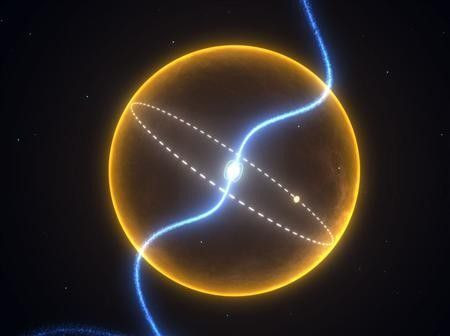Diamond Planet Found Orbiting a Pulsar [PHOTOS & VIDEOS]

Listen up ladies (and any gentlemen with a spaceship), astronomers say they have discovered an exotic planet seemingly made of diamonds that's five times the size of Earth and with more mass than Jupiter.
And get this, the diamond-crystal planet was discovered in our own Milky Way galaxy.
The shiny planet is orbiting the pulsar PSR J1719-1438. It's believed to be denser than platinum, but made entirely of oxygen and carbon.
The cosmic bling was found by an international team of astronomers led by Swinburne University of Technology in Australia. They spotted the planet using the Parkes radio telescope in New South Wales, Australia
The evolutionary history and amazing density of the planet all suggest it is comprised of carbon - i.e. a massive diamond orbiting a neutron star every two hours in an orbit so tight it would fit inside our own Sun, said Matthew Bailes of Swinburne University of Technology in Melbourne, to Reuters.
The pulsar that the planet orbits is 4,000 light years away.
Pulsars are tiny stars the sporadically give off a burst of radio waves. They are formed when the core of a large star is compressed during a supernova and collapses into a neutron star. It then gives off radiation during a fixed period.
Just how many carats are we talking about floating around out there in our backyard?
Well, the researchers weren't certain what the planet would look like up close, but they think the forces upon the planet, which is believed to be the universe's largest diamond - a shocking 1031 carats worth - are so extreme, that it must be largely crystalline.
And for those of you wealthy men who love to pamper the ladies with luxury items, you may know that one carat of diamond can put you out of pocket about $5,000. And if diamond planet is 1031, that's 10,000,000,000,000,000,000,000,000,000,000, then do the math.
What an expensive rock!
It's highly speculative, but if you shine a light on it, I can't see any reason why it wouldn't sparkle like a diamond, Travis Metcalfe of the National Center for Atmospheric Research in Boulder, Colo., told New Scientist.
The research is published in Thursday's issue of the journal Science.
Check out these videos of the diamond planet below.
So what sound does a pulsar make?
© Copyright IBTimes 2025. All rights reserved.






















